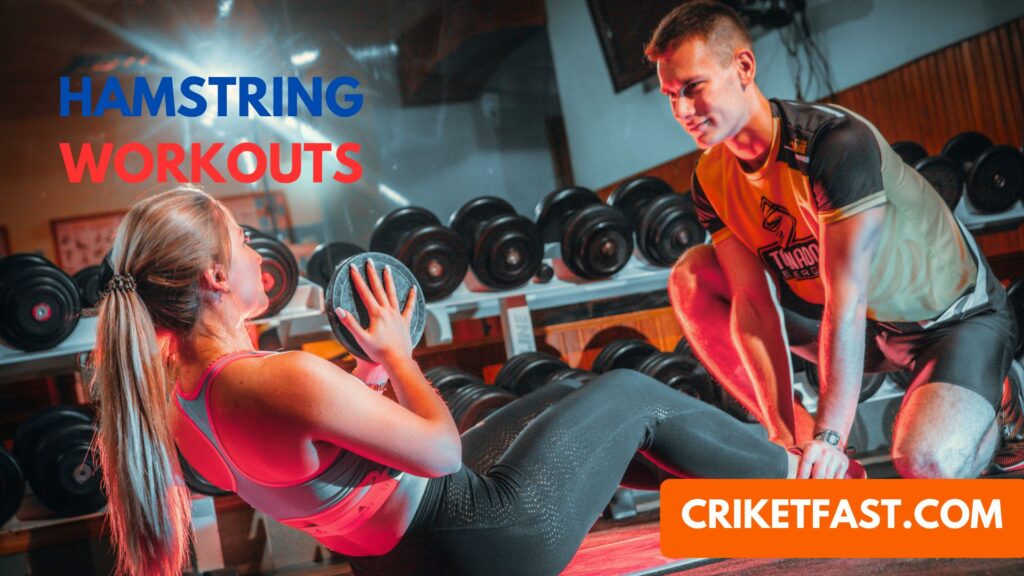Best Hamstring Workouts
If your hamstrings are weak, then there is a good chance that you are not getting the most out of your strength potential when squatting and deadlifting. In addition, a lack of hammy eccentric strength is one of the most common causes of hammy strains.
Training your hamstrings is a great way to improve performance, look good, and prevent injury. Hamstrings are the extensors of the hip and the flexors of the knees. Therefore, training both ways is beneficial.
The best hamstring exercises for performance, strength and hypertrophy are broken down below with the help of multi-weightlifting world record holder, Dr. Stefi cohen, DPT.

THE ANATOMY OF THE HAMSTRING MUSCLES
The hamstrings are located on the back of your thigh and are composed of four muscles:
- Biceps Femoris (long head and short head)
- Semitendinosus
- Semimembranosus
The primary function of the hamstrings is to flex at the knee joint in addition to helping with hip extension and helping with thigh rotation. That’s why we try to mimic the above actions when training hamstrings. For example, using the leg curl machine to add resistance to the knee flexion and the Romanian deadlifts to add resistance to your lengthened ham and hip extension.
However, the hammy muscles don’t work in isolation. To properly strengthen and grow the hammy muscles, you’ll need to recruit from your quads and glutes as well as other stabilizing muscles.
If you’re looking to hit your hamstrings hard, then keeping your back and back in good shape will help you avoid injury! Try these back stretches for improved flexibility!
7 Best Hamstring Exercises
1.Lying Leg Curl
Lying leg curls are not well-known and are often done incorrectly. However, when done correctly and with full range of movement, it strengthens your hamstrings and calves. When performing the lying leg curl, it is important to keep your hips and your upper body stable to ensure that only your hamstrings are moving.
The lying leg curl improves the flexibility of your hamstrings and isolates your hammies completely, eliminating the need for supporting muscles such as the glutes and lower back.
How To Do It
- On the leg curl machine, lie on your back with your ankles tucked under the pad. Keep your hips down and draw your belly button in to avoid movement compensation.
- Curl the weight towards your glutes.
- Lift slowly to get the most time under pressure during the eccentric part. Repeat.
Coach’s Tip: Actively press your pelvis into the pad.
Sets and Reps: Try 2 to 3 sets of 8 to 12 repetitions
2.Hamstring Slide
The Hamstring Slide utilizes your hamstrings for their role as hip extenders and knee flexors. This Hamstring Slide is simpler than the Razor Curl (more on that below).
You may choose to begin with this one to increase your eccentric hamstrings strength to reduce the risk of hamstring strain. Another advantage is that it doesn’t require any weight to press on the muscle, making it easy on the joints.
How To Do It
Get on your back on all fours with your knees bent at a 90-degree angle and your heels below your knees. Your heels should be on workout sliders. For this at home exercise, you can put your heels on socks on your hardwood floor.
To do this, squeeze your glutes and lift your hips. Then, lower your heels to the floor until you’re almost at the full length of your legs.
Bring your heels back under your knees, flex your hamstrings, and repeat.
Coach’s Tip: If you’re doing this at home, you can place your heels on a pair of socks on a hardwood floor.
Sets and Reps: Go for 3 to 4 sets of 8 to 10 repetitions.
3.Toes-Elevated Dumbbell Romanian Deadlift
The Romanian deadlift is a great addition to your deadlift routine and adds strength and muscle mass to your quads and glutes. With the toes-up variation, you can take it to the next level.
When the toes are lifted, the weight is shifted back onto the heels, which further isolates and strengthens the hamstrings.
When performed in a slow eccentric position, it will help strengthen your hamstrings in a longer position to prevent strain.
How To Do It
Use a 25 pound bumper plate or a low platform to raise your toes and bring your feet closer together.
As you hinge, reach out and follow the dumbbells over your toes instead of holding them near your body.
To feel the stretch correctly, adjust the eccentric speed.
Stop at the bottom position for a few seconds, then start up again.
Coach’s Tip: You needn’t elevate your toes too high. Half an inch to an inch of height should do the trick.
Sets and Reps: Try out 3 to 4 sets of 8 to 12 repetitions.

4.Dumbbell Good Morning
Barbell good morning is an excellent movement for loading the hamstrings. However, not everyone has enough shoulder movement to reach behind the barbell to stabilize it. Or, with all the compression/shear loading from squat and deadlift, your spine may need a break.
The dumbbell good morning engages the anterior core and works the same muscles as a barbell, but without the strain on your spine. With the weight in the anterior position, you’ll also be more mindful of your upper body positioning.
How To Do It
- Grab a dumbbell and hold it against your chest, shoulders down, chest up.
- Kneel with a gentle bend in your knees.
- Hinge at your hips until you’re almost flat on the floor, keeping your back flat.
- Stop for a few seconds and go back to where you left off.
- Do it again.
Coach’s Tip: Squeeze your lats to help keep the dumbbell firmly against your torso.
Sets and Reps: Bang out 2 or 3 sets of 10 to 15 repetitions.
5.Razor Curl
A variation of the Nordic curl, the razor curl requires you to flex your hips. Folding your hips allows for a stronger contraction of your hamstrings at your hip and a stronger contraction at your knee.
It also reduces the risk of ACL injury. However, this is an advanced exercise and should only be done after you have developed your eccentric hamstring strength (1).
How To Do It
- Use a training partner to hold your legs or barbell/tool to hold your lower body in place.
- Flex your hips slightly and hold this position throughout the exercise.
- Fall forward while maintaining the eccentric and touch the ground lightly.
Coach’s Tip: Use your hands to assist on the concentric if you’re starting to help make it easier.
Sets and Reps: 1 to 2 sets of 3 to 5 repetitions is more than enough.
6.Barbell Good Morning
The Barbell good morning exercise works your lower back, your glutes, and your hamstrings as a group. You work your glutes and your hamstrings through a wide range of motion to build muscle and strengthen your posterior musculature.
This move necessitates a high degree of shoulder mobility in order to hold the bar. If shoulder mobility is a problem for you, you can always switch to a dumbbell good morning. Either way, a good morning is an amazing way to test your hamstrings with ultra-light weights.
How To Do It
- Load the barbell in your power rack.
- Put the barbell in the rack and unrack it as if you’re going to do a back squat. Walk the barbell out.
- Bend your knees slightly and hinge at your hips, keeping your chest up and your shoulders down.
- Hang until your torso is nearly parallel to the floor, then contract your glutes and hams to get back to your standing position.
- Re-rack and repeat.
Coach’s Tip: Isometrically contract your upper back to pull the bar into your body as you hinge over.
Sets and Reps: Try 2 or 3 sets of 8 to 10 repetitions.
7.Romanian Deadlift
The RDL (Romanian deadlift) is a variation of the traditional deadlift. Instead of reaching the floor between each rep, the RDL requires you to stop the bar in the middle of the lift.
This adjustment maintains a constant pressure on your hamstrings and glutes. This pressure makes RDL’s a more effective way to build muscle mass in these areas.
How To Do It
- Stand up straight
- Feet hip-width apart, and grip the barbell overhand in front of your thighs.
- Keep your arms and shoulders relaxed. Hinge the barbell until it’s below your knees.
- Engage your lats and squeeze your glutes to pull yourself back to your standing position, then reset and repeat.
Coach’s Tip: Always keep the barbell close to your body without dragging it up your legs.
Sets and Reps: 3 to 5 sets of 5 to 8 repetitions will work wonders here.

Read More:The Best Pole Fitness for Girls in Gym
Conclusion
In conclusion, training your hamstrings is crucial for improving performance, preventing injury, and enhancing aesthetics. By incorporating a variety of hamstring exercises that target different muscle functions, you can effectively strengthen and grow your hamstrings while also engaging other supporting muscles for overall development and injury prevention.
FAQs About Hamstrings
Q1: Why is it important to train hamstrings?
A: Hamstrings improve performance, look good, and prevent injury. Hamstrings help with hip flexion and knee flexion.
Q2: What are the four hamstring muscles?
A: Biceps Femoris (long and short head), Semitendinosus, and Semimembranosus.
Q3: What exercises target both knee flexion and hip extension for hamstring training?
A: Leg curl machine (knee flexion) and Romanian deadlifts (hip extension).
Q4: Why should you avoid isolating hamstring exercises?
A: Hamstring muscle works in conjunction with quadriceps, glutes and other stabilisers. Isolated exercises can cause imbalance.
Q5: What is the proper form for lying leg curls?
A: Rest your hips and upper body, making sure only your hamstrings are in full-body movement.
Q6: Which exercise is best for improving eccentric strength in hamstrings?
A: Romanian deadlifts involve gradually reducing the weight while maintaining a prolonged stance.
Q7: What is the benefit of performing Nordic hamstring curls?
A: They also build up eccentric strength which is essential for avoiding hamstrings.

